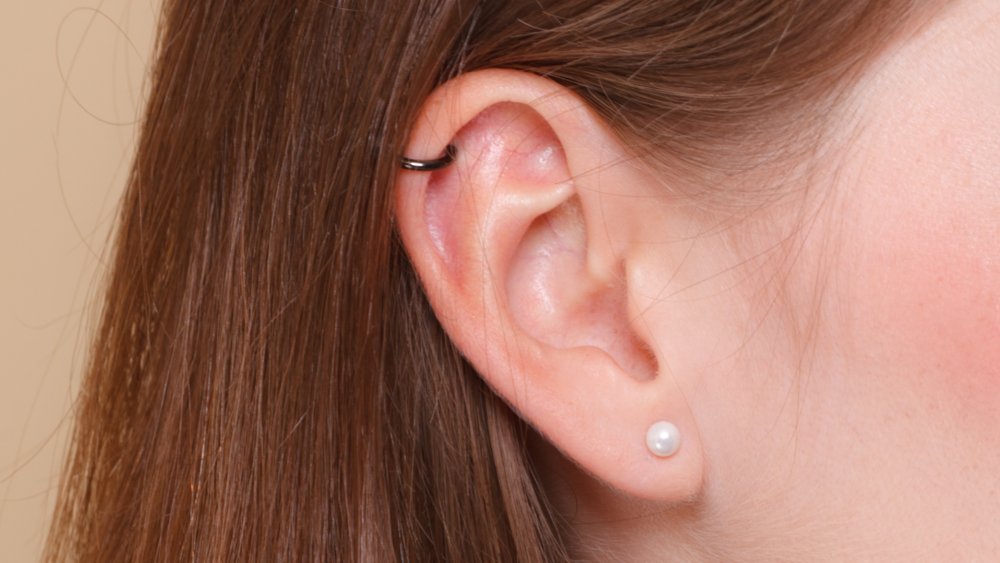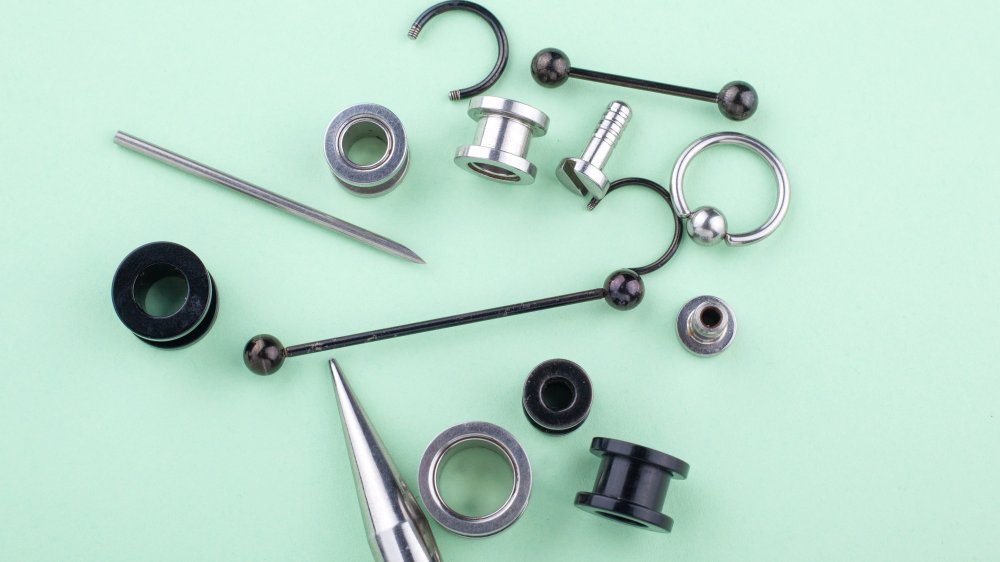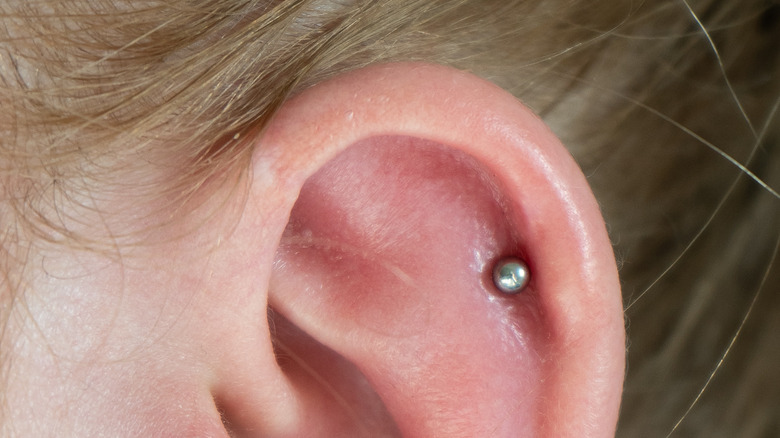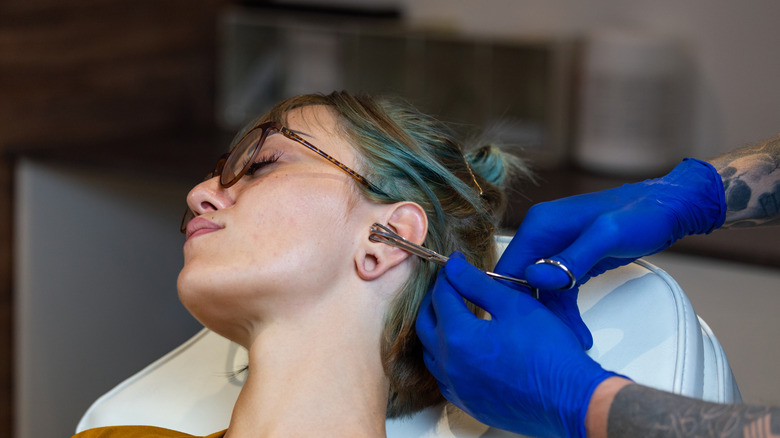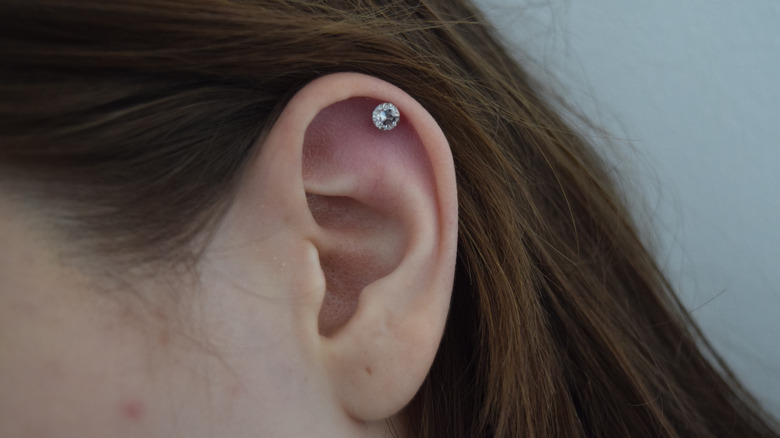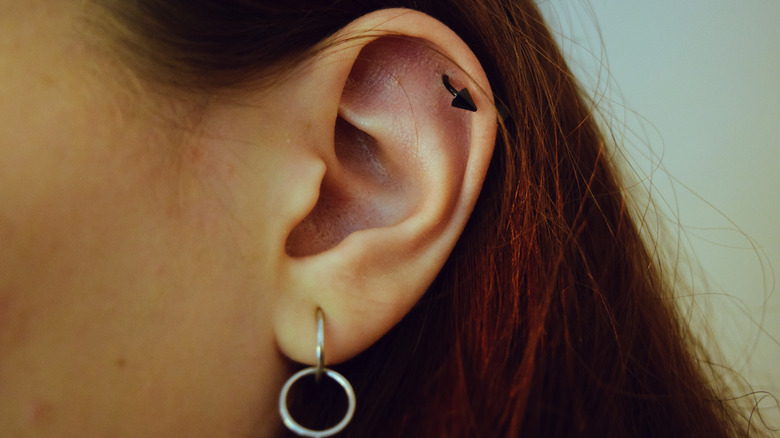The Truth About Helix Piercings
In 2019, Miley Cyrus brought our attention to helix piercings. Situated almost anywhere along the upper rim of the ear, when we last counted, she had over five on her left ear alone. And now, we can't stop thinking about getting a few ourselves. But we have questions. Lucky for us, Kevin Lamb, head piercer at Maria Tash in Liberty London, spoke to Byrdie and discussed everything you need to know about helix piercing before getting on yourself.
Lamb believes that helix piercings suit almost everyone. As the upper ear rim is quite long, you can choose whether you want a stud or a ring then place it anywhere you feel comfortable with. In terms of pain, Lamb claims it hurts a little less than getting your eyebrows done, adding, "Of course, cartilage is going to pinch a wee bit more than a normal lobe, but if it's the location you want, don't let that side of things worry you too much — most procedures are over and done with very quickly."
Helix piercings can take up a to a year to heal
According to pro piercer Kevin Lamb, helix piercings can take anywhere from three months to a year to heal, admitting he'll never do more than three piercings at a time, as the healing can take even longer. Other cartilage piercings, such as the conch piercing or the tragus piercing, can have similar healing times as well, so this isn't totally unusual.
However, just because your piercing may feel normal after three months, it doesn't mean it has fully healed, and Lamb advises those with new piercings to sleep with a certain type of pillow to combat any aggravation. "I always suggest that clients get a travel pillow and just put their ear in the middle of the hole when sleeping; it stops you from putting a prolonged amount of pressure onto the area, and also your body will wake you up if you try roll onto it, so it really helps with the healing process," he told Byrdie.
Immediate aftercare of a helix piercing is just as important as it is with any other piercing. To avoid infection, Lamb recommends using saline solution on a paper towel and dabbing it around the hole multiple times then drying with your hair dryer (with the heat on low, obviously). "Do this twice a day for around two to three months without picking, playing or twisting your piercing," Lamb advised. Once it's fully healed, continue to keep up a regular cleaning routine and avoid touching at all times.
There's a chance your helix piercing will get infected
While we don't want to scare you off of getting a helix piercing, you should be aware that this is not a low-maintenance body modification. Even if you're taking proper care of the piercing and keeping it clean, these types of piercings are prone to infection. While taking care of the piercing definitely lowers your risk of infection, a study published in the American Journal of Otolaryngology found that around 30% of cartilage piercings will end up getting infected. This statistic may sound daunting, but ChildrensMD notes that most infections can be easily treated with antibiotics. It's important to keep an eye on the site of the piercing since early intervention is key.
If you suspect an infection, make an appointment with your doctor who can prescribe the best course of treatment. If things are really bad — meaning that you're seeing pus or even an abscess around the piercing site — keep calm but head to urgent care. ChildrensMD warns that an infection this bad could lead to a "permanent loss of ear cartilage" if not treated as soon as possible.
Helix piercings should be done with a needle
You may have gotten your ear lobes pierced at Claire's by a teenager wielding a piercing gun when you were younger, but this is an experience you definitely should not repeat when getting your helix piercing. Generally speaking, piercing guns are not the way to go. According to TatRing, people using piercing guns are less likely to be trained piercing professionals and the force needed to go through the cartilage for your helix piercing could result in broken cartilage. This is a scenario you especially want to avoid if you're squeamish around blood because piercing guns tend to cause more of a mess than piercings done with a needle.
Piercing guns simply weren't designed to go through cartilage, but a needle will do the job just fine. In fact, piercing pro Brian Keith Thompson — who is trusted by none other than Beyoncé for her piercing needs — told Elle that needles are "actually way less painful" than piercing guns as "they're designed to pierce skin, whereas a gun just delivers blunt force to push an earring through."
You should use a high-quality metal for your initial piercing
If you're getting a helix piercing, be prepared to fork over some money for high-quality bling. While you could get some cheap jewelry, pricier metals are the best way to go, as noted by Pierced. They recommend buying jewelry made of titanium or 14k gold, recommending gold in particular because you're less likely to have an allergic reaction to it and it's easier to keep clean.
As for the shape of the jewelry, it's recommended to choose a stud over anything else. It'll be easier for the piercing to heal, which means that you'll be able to swap it out for the jewelry you really want sooner. Once your piercing is all healed up, you can choose any type of jewelry you want for your helix piercing, whether that's a stud, a hoop, or something else. You'll also be able to choose any kind of metal you want once the piercing is healed.
You'll have to wait a while before removing your new piercing
Helix piercings look really cool, but one of the major downsides is the long healing process. While you might be prepared to take care of the piercing until it heals, keep in mind that it will be a while before you can show off all the new jewelry you bought for it. The first piece of jewelry you choose for your piercing is important not only to avoid infection, but also because you'll be wearing it for a few months as the piercing heals.
As ear piercer Brian Keith Thompson explained to Elle, "even if it looks good, it's still healing." You don't want to take your new earring out until it's fully healed; Thompson said that, even after you take it out, you shouldn't leave it out because the hole could close up. You can, however, finally switch it out for a different earring.
Getting a helix piercing is a commitment and, for the first few months at least, you're going to want to keep an earring in it almost non-stop to avoid it closing up. The older the piercing is, the longer you can go without having jewelry in it. According to Thompson, a piercing that is only a few months old shouldn't be without jewelry "longer than a few hours" but one that's a few years old "can be left for five weeks if you wanted."
There are different types of helix piercings
You may have decided to get a helix piercing, but what kind of helix piercing are you going to get? Contrary to what you may think, there's more than one kind of helix piercing out there. Grazia broke down the many kinds of helix piercings there are. You already know that a helix piercing can be found on the upper cartilage. Some people opt to get their cartilage double pierced, which is referred to as a double helix.
Helix piercings at the piece of cartilage where your ear meets your head are called forward helix piercings, anti-helix piercings, or inner helix piercings. If you want to line a another piercing above your forward helix piercing, it's called a double forward helix piercing.
If you can't keep all that straight, don't worry — when you go in for your piercing, just point to the area (or areas) of your ear cartilage that you want pierced and your piercer should be able to take it from there.
